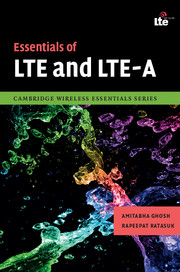Book contents
7 - Comparison of broadband technologies
Published online by Cambridge University Press: 05 August 2011
Summary
Introduction
LTE Rel-8 and WiMAX are the two main wireless broadband technologies based on OFDM which are currently being commercialized. Both of these technologies are being enhanced (LTE-Advanced and 802.16m) so as to support higher peak rates, higher throughput and coverage, and lower latencies, resulting in a better user experience. Further, both LTE-Advanced and 802.16m were approved by the ITU as IMT-Advanced technology. Also several operators are considering deploying both these technologies or migrating their existing WiMAX system to LTE or 802.16m. In this chapter, these two main broadband technologies are compared with respect to their features and system performance. Also, WiMAX and LTE co-existence and migration scenarios are briefly discussed.
- Type
- Chapter
- Information
- Essentials of LTE and LTE-A , pp. 222 - 237Publisher: Cambridge University PressPrint publication year: 2011

